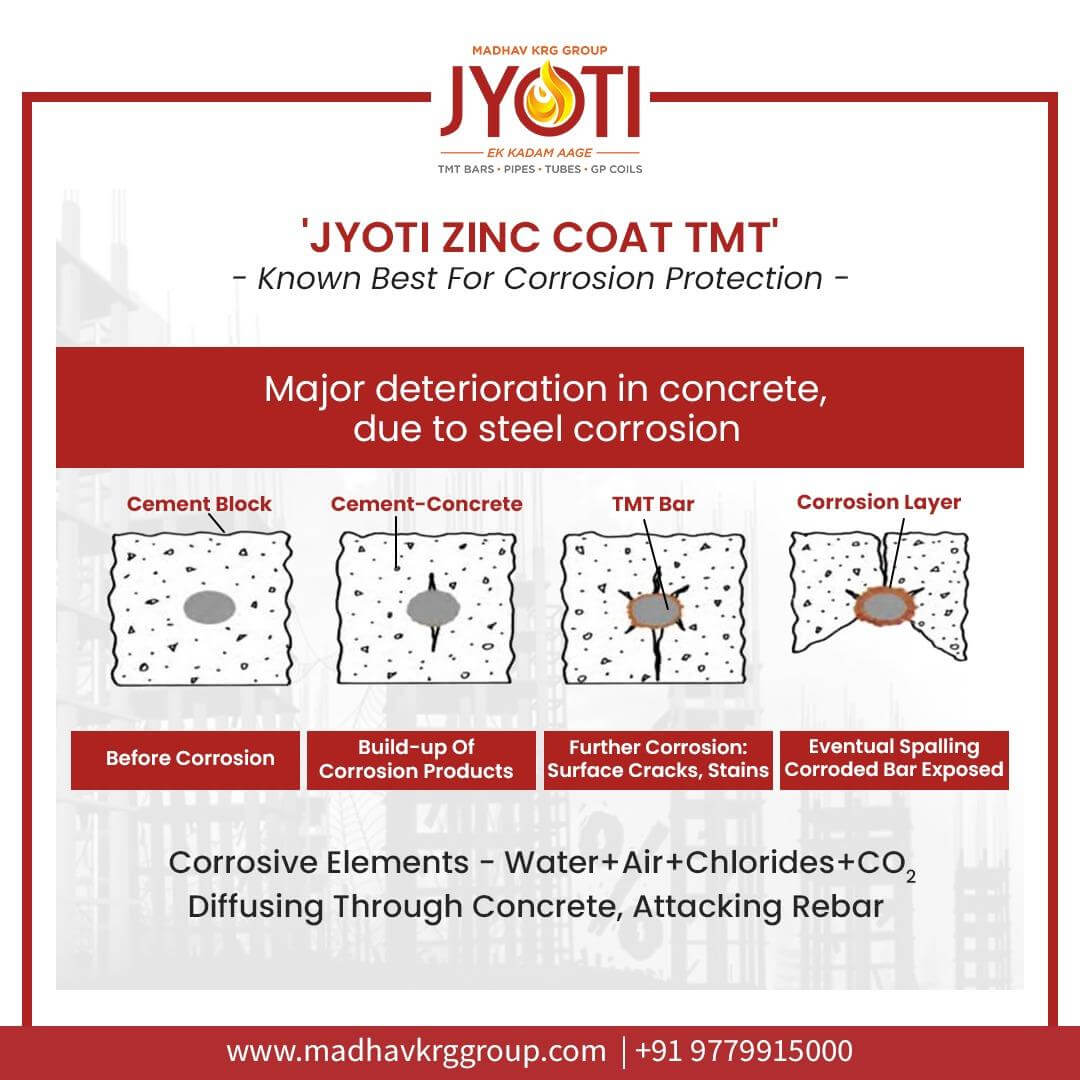
Say Good Bye To Rust
Recommended Current Price
JYOTI ZNCOAT TMT 550D
ViewHelpline Number : 97799-15000
Cracks in concrete construction are inevitable. Sometimes, the cracks are just cosmetic and not a cause of concern. They can also be fixed easily with solutions such as epoxy injections, stitching, grouting and sealing, etc. But at other times, cracks can be large and deep and thus degrade the safety and integrity of the building. Cracks occur due a variety of reasons and there are ways to prevent them keeping their probable causes in mind. Following are the major reasons for cracks in concrete construction along with remedies for them -

1.Initial Cracking - Brickwork and concrete shrink upon drying. This shrinkage is inevitable and causes cracks in the construction. This shrinking and subsequent cracking can be minimised by using the optimum ratio of cement in the mortar and allowing it to dry properly before doing the final plastering. Excessive water will cause more shrinkage so the quantity of water needs to be regulated. Also, the cement mix should be prepared using a mechanical mixer and vibrator for consistency.
2.Geological Vibrations and Movements - The earth experiences movement and vibration all the time owing to seismic activity, mining subsidence, land slips and shrinkage in soil due to changes in moisture content. These vibrations and movements, if they are too intense, can affect the structures on the ground and cause cracks in them. Cracking from geological vibrations and movements can be minimised by making firm foundations and giving support to buildings with pillars and beams. Using reinforced concrete with galvanised TMT bars can make a significant positive difference to the strength and integrity of buildings and make them more resilient.
3.Permeability of Concrete - If the concrete being used is highly permeable, then it is more likely to get affected by weathering, chemical agents and other processes of deterioration. To minimise cracking in structures, concrete needs to have lower permeability. For lower permeability, the concrete-cement ratio should be optimum, admixtures should be used and the initial structures should be allowed to cure properly in the right temperature before plastering.
4.Thermal Movement - It is a known fact that materials expand on heating and shrink on cooling. So, changes in the weather is also a factor that causes cracking. In India, diurnal and seasonal changes are generally in the range of 5°C to 20°C and 0°C to 25°C, respectively. Cracking due to thermal movement can be minimised by using joints such as construction joints, expansion joints, control joints and slip joints. These joints should be planned at the time of design and placed strategically for maximum effectiveness.
5.Creep Movement - Gradual deformation of concrete over a period of time due to sustaining load is called creep. Creep movement is accelerated if the quantity of cement or water in the cement mix is high. Using admixtures and pozzolans, and increased temperature of TMT bars also lead to higher creep movement. Using minimum quantity of water in the cement mix, using large coarse aggregate, providing compression reinforcement, curing concrete properly and giving optimum time before formwork removal can help decrease creep.
6.Corrosion of TMT Bars - Corrosion of TMT bars is a major reason for cracks in construction. Elements in the environment such as water, gases and chlorides diffuse through the concrete matrix to reach the rebar and corrode it. To remedy this, galvanized rebars should be used. They have significantly better corrosion-resistant properties than ordinary rebars. The galvanized zinc also reacts in the presence of water to create rust-resistance at the point of any surface damage, thus making the rebar self-healing. Furthermore, the galvanizing process creates alloy layers on the surface that are harder than many base steels and increases the bond strength by 2 to 3 percent. Galvanized TMT bars also have a benefit in terms of cost as they have a lower life-cycle cost as compared to ordinary rebars.
Madhav KRG Group, a leading steel manufacturing company, commissioned Asia’s first-ever Continuous Galvanized Rebar (CGR) manufacturing facility recently. The new CGR facility will further increase the usage of zinc in the steel industry with German machinery and stringent quality checks, their product range can be checked here - https://www.madhavkrggroup.com/tmt-bars.php